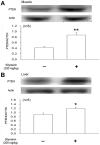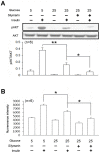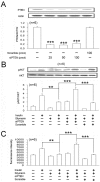Silymarin induces insulin resistance through an increase of phosphatase and tensin homolog in Wistar rats
- PMID: 24404172
- PMCID: PMC3880317
- DOI: 10.1371/journal.pone.0084550
Silymarin induces insulin resistance through an increase of phosphatase and tensin homolog in Wistar rats
Abstract
Background and aims: Phosphatase and tensin homolog (PTEN) is a phosphoinositide phosphatase that regulates crucial cellular functions, including insulin signaling, lipid and glucose metabolism, as well as survival and apoptosis. Silymarin is the active ingredient in milk thistle and exerts numerous effects through the activation of PTEN. However, the effect of silymarin on the development of insulin resistance remains unknown.
Methods: Wistar rats fed fructose-rich chow or normal chow were administered oral silymarin to identify the development of insulin resistance using the homeostasis model assessment of insulin resistance and hyperinsulinemic- euglycemic clamping. Changes in PTEN expression in skeletal muscle and liver were compared using western blotting analysis. Further investigation was performed in L6 cells to check the expression of PTEN and insulin-related signals. PTEN deletion in L6 cells was achieved by small interfering ribonucleic acid transfection.
Results: Oral administration of silymarin at a dose of 200 mg/kg once daily induced insulin resistance in normal rats and enhanced insulin resistance in fructose-rich chow-fed rats. An increase of PTEN expression was observed in the skeletal muscle and liver of rats with insulin resistance. A decrease in the phosphorylation of Akt in L6 myotube cells, which was maintained in a high-glucose condition, was also observed. Treatment with silymarin aggravated high-glucose-induced insulin resistance. Deletion of PTEN in L6 cells reversed silymarin-induced impaired insulin signaling and glucose uptake.
Conclusions: Silymarin has the ability to disrupt insulin signaling through increased PTEN expression. Therefore, silymarin should be used carefully in type-2 diabetic patients.
Conflict of interest statement
Figures




Similar articles
-
Role of tumor suppressor PTEN in tumor necrosis factor alpha-induced inhibition of insulin signaling in murine skeletal muscle C2C12 cells.Horm Metab Res. 2007 Mar;39(3):173-8. doi: 10.1055/s-2007-970414. Horm Metab Res. 2007. PMID: 17373630
-
Increase of phosphatase and tensin homolog by silymarin to inhibit human pharynx squamous cancer.J Med Food. 2013 Sep;16(9):778-84. doi: 10.1089/jmf.2012.2534. Epub 2013 Aug 3. J Med Food. 2013. PMID: 23909904 Free PMC article.
-
Suppression of phosphatase and tensin homolog protects insulin-resistant cells from apoptosis.Mol Med Rep. 2015 Aug;12(2):2695-700. doi: 10.3892/mmr.2015.3771. Epub 2015 May 12. Mol Med Rep. 2015. PMID: 25962562
-
Roles of phosphatase and tensin homolog in skeletal muscle.J Cell Physiol. 2019 Apr;234(4):3192-3196. doi: 10.1002/jcp.26820. Epub 2018 Nov 23. J Cell Physiol. 2019. PMID: 30471096 Review.
-
PTEN, Insulin Resistance and Cancer.Curr Pharm Des. 2017;23(25):3667-3676. doi: 10.2174/1381612823666170704124611. Curr Pharm Des. 2017. PMID: 28677502 Review.
Cited by
-
Silymarin inhibits the progression of Ehrlich solid tumor via targeting molecular pathways of cell death, proliferation, angiogenesis, and metastasis in female mice.Mol Biol Rep. 2022 Jun;49(6):4659-4671. doi: 10.1007/s11033-022-07315-2. Epub 2022 Mar 19. Mol Biol Rep. 2022. PMID: 35305227
-
Therapeutic Potential of Silymarin in Mitigating Paclitaxel-Induced Hepatotoxicity and Nephrotoxicity: Insights into Oxidative Stress, Inflammation, and Apoptosis in Rats.Balkan Med J. 2024 May 3;41(3):193-205. doi: 10.4274/balkanmedj.galenos.2024.2024-1-60. Balkan Med J. 2024. PMID: 38700358 Free PMC article.
-
Silymarin Reduced Insulin Resistance in Non-Diabetic Women with Obesity.Int J Mol Sci. 2024 Feb 8;25(4):2050. doi: 10.3390/ijms25042050. Int J Mol Sci. 2024. PMID: 38396727 Free PMC article.
-
Natural Agents Used in Chemoprevention of Aerodigestive and GI Cancers.Curr Pharmacol Rep. 2016 Feb;2(1):11-20. doi: 10.1007/s40495-016-0047-0. Epub 2016 Jan 16. Curr Pharmacol Rep. 2016. PMID: 27134816 Free PMC article.
-
Taurine Attenuates Hepatic Inflammation in Chronic Alcohol-Fed Rats Through Inhibition of TLR4/MyD88 Signaling.J Med Food. 2015 Dec;18(12):1291-8. doi: 10.1089/jmf.2014.3408. Epub 2015 Jun 19. J Med Food. 2015. PMID: 26090712 Free PMC article.
References
-
- Contos MJ, Choudhury J, Mills AS, Sanyal AJ (2004) The histologic spectrum of nonalcoholic fatty liver disease. Clin Liver Dis 8: 481–500. - PubMed
-
- Marchesini G, Babini M (2006) Nonalcoholic fatty liver disease and the metabolic syndrome. Minerva Cardioangiol 54: 229–239. - PubMed
-
- Williams R (2006) Global challenges in liver disease. Hepatology 44: 521–526. - PubMed
-
- Flora K, Hahn M, Rosen H, Benner K (1998) Milk thistle (Silybum marianum) for the therapy of liver disease. Am J Gastroenterol 93: 139–143. - PubMed
-
- Jacobs BP, Dennehy C, Ramirez G, Sapp J, Lawrence VA (2002) Milk thistle for the treatment of liver disease: a systematic review and meta-analysis. Am J Med 113: 506–515. - PubMed
Publication types
MeSH terms
Substances
LinkOut - more resources
Full Text Sources
Other Literature Sources
Medical
Research Materials

